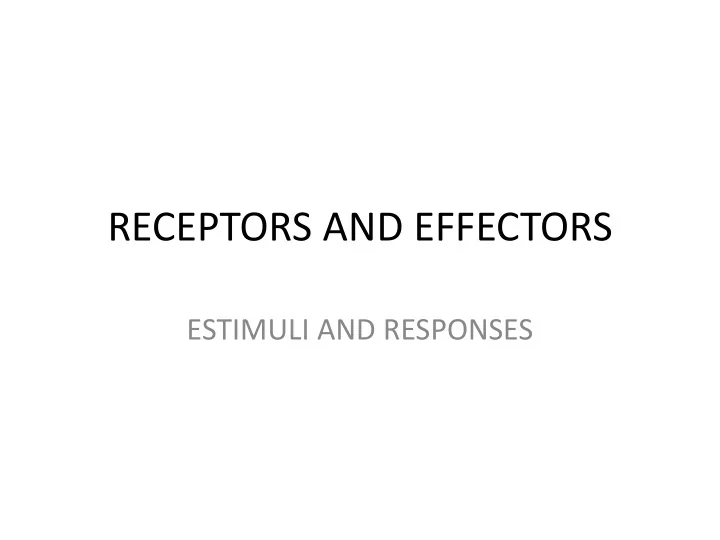

RECEPTORS AND EFFECTORS ESTIMULI AND RESPONSES
SENSORY RECEPTORS • They are responsible for perceiving information, which they convert into a nerve impulse. • According to their location they can be: – External: sensory organs – Internal • According to the nature of the stimuli: photoreceptors, chemoreceptors, mechanoreceptors, thermoreceptors.
THE EYES AND THE SIGHT ACCESORY ORGANS 1) Write down the role of each accesory organ indicated in your book (page 30). Be careful, there is a mistake in your book about the location of the lacrimal glands, observe the following picture to correct it. Lacrimal glands They secrete tears … Lacrimal sac It takes the excess of tears and brings them to the nose cavity 2) First cameras were very simple and they were called camerae obscurae, can you guess what is the entrance door of light to the eye?
HANDCRAFT CAMERA OBSCURA 3) The pupil is the entrance door of light to the eye, what other structure of the eye anatomy is equivalent to the photographic paper? Notice in the picture where the photographic paper is placed.
OCULAR GLOBE ANATOMY 2 1 4 6 3 5 5) Name the anatomy parts of the eye labelled with numbers. Notice again there is a mistake in your book about the iris location (2 in this picture). Iris in your book is pointing to where aqueous humour is.
6) With the help of your book (pages 30 and 31), Compare the human eye anatomy to the components of a camera. Write down in your notebook: 6.1. Where is the quantity of light that enters the eye regulated? 6.2. Where is the focus made? 6.3. Where are the photoreceptors located? 6.4. What is the name of the two types of human photoreceptors? Tell which one is in charge of seeing colours and which one of seeing contrast. 6.5. Make activity 7 (página 31). Explain how it is possible that the image formed in the retina is inverted while we see images the right way up.
Regulation of the light intensity that enters the eye 7.1) Too much light intensity can harm our photoreceptors, how does the iris respond and what does it happen to the pupil? 7.2) With too dim light we might see, how does the iris respond and what does it happen to the pupil? 7.3) When we enter a dark room from an iluminated place, it takes us some seconds to start to see. Why do you think it happens so? 7.4) Why do you think parasympathetic and sympathetic is indicated in the picture?
Lens adaptation for focusing 8.1. What does it happen to lens (cristalino) when we focus objects close to us? 8.2. What does it happen to lens (cristalino) when we focus objects far from us? 8.3. Lens lose their flexibility (or adaptation capability) with aging, investigate what presbyopia is.
SIGHT DEFECTS Myopia Hyperopia (=farsightedness) 9.1) With the help of your book (page 42), indicate where images are formed in myopia and hyperopia. 9.2) What is the consequence of not focusing images in the retina?
SIGHT DEFECTS 10.1) Which sight defect is the picture above representing? How do we manage to correct it? 10.2) Which sight defect is corrected with glasses made of convex lens?
SIGHT DEFECTS 11.1) Complete the following table: Sight defect Anatomic cause Consequences Myopia Distant objects are seen blurred. Hyperopia Eyeball too short Astigmatism Cataracts Gradual blindness Presbyopia Lose of lens ’ ability to focus
Recommend
More recommend